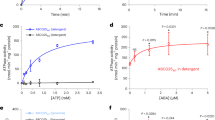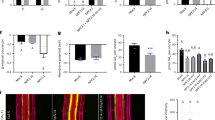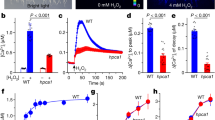Abstract
Abscisic acid (ABA) is a vital phytohormone that regulates mainly stomatal aperture and seed development, but ABA receptors involved in these processes have yet to be determined. We previously identified from broad bean an ABA-binding protein (ABAR) potentially involved in stomatal signalling, the gene for which encodes the H subunit of Mg-chelatase (CHLH), which is a key component in both chlorophyll biosynthesis and plastid-to-nucleus signalling. Here we show that Arabidopsis ABAR/CHLH specifically binds ABA, and mediates ABA signalling as a positive regulator in seed germination, post-germination growth and stomatal movement, showing that ABAR/CHLH is an ABA receptor. We show also that ABAR/CHLH is a ubiquitous protein expressed in both green and non-green tissues, indicating that it might be able to perceive the ABA signal at the whole-plant level.
This is a preview of subscription content, access via your institution
Access options
Subscribe to this journal
Receive 51 print issues and online access
$199.00 per year
only $3.90 per issue
Buy this article
- Purchase on SpringerLink
- Instant access to full article PDF
Prices may be subject to local taxes which are calculated during checkout




Similar content being viewed by others
References
Leung, J. & Giraudat, J. Abscisic acid signal transduction. Annu. Rev. Plant Physiol. Plant Mol. Biol. 49, 199–222 (1998)
Finkelstein, R. R., Gampala, S. S. & Rock, C. D. Abscisic acid signaling in seeds and seedlings. Plant Cell 14, S15–S45 (2002)
Himmelbach, A., Yang, Y. & Grill, E. Relay and control of abscisic acid signaling. Curr. Opin. Plant Biol. 6, 470–479 (2003)
Hornberg, C. & Weiler, E. W. High affinity binding sites for abscisic acid at the plasmalemma of Vicia faba guard cells. Nature 310, 321–324 (1984)
Zhang, D. P., Wu, Z. Y., Li, X. Y. & Zhao, Z. X. Purification and identification of a 42-kilodalton abscisic acid-specific-binding protein from epidermis of broad bean leaves. Plant Physiol. 128, 714–725 (2002)
Razem, F. A., Luo, M., Liu, J. H., Abrams, S. R. & Hill, R. D. Purification and characterization of a barley aleurone abscisic acid-binding protein. J. Biol. Chem. 279, 9922–9929 (2004)
Razem, F. A., El-Kereamy, A., Abrams, S. R. & Hill, R. D. The RNA-binding protein FCA is an abscisic acid receptor. Nature 439, 290–294 (2006)
Walker, C. J. & Willows, R. D. Mechanism and regulation of Mg-chelatase. Biochem. J. 327, 321–333 (1997)
Mochizuki, N., Brusslan, J. A., Larkin, R., Nagatani, N. & Chory, J. Arabidopsis genomes uncoupled 5 (GUN5) mutant reveals the involvement of Mg-chelatase H subunit in plastid-to-nucleus signal transduction. Proc. Natl Acad. Sci. USA 98, 2053–2058 (2001)
Surpin, M., Larkin, R. M. & Chory, J. Signal transduction between the chloroplasts and the nucleus. Plant Cell 14, S327–S338 (2002)
Strand, Å., Asami, T., Alonso, J., Ecker, J. R. & Chory, J. Chloroplast to nucleus communication triggered by accumulation of Mg-protoporphyrinIX. Nature 421, 79–83 (2003)
Nott, A., Jung, H. S., Koussevitzky, S. & Chory, J. Plastid-to-nucleus retrograde signaling. Annu. Rev. Plant Biol. 57, 730–759 (2006)
Giraudat, J. et al. Isolation of the Arabidopsis ABI3 gene by positional cloning. Plant Cell 4, 1251–1261 (1992)
Nambara, E., Naito, S. & McCourt, P. A mutant of Arabidopsis which is defective in seed development and storage protein accumulation is a new abi3 allele. Plant J. 2, 435–441 (1992)
Karger, G. A., Reid, J. D. & Hunter, C. N. Characterization of the binding of deuteroporphyrin IX to the magnesium chelatase H subunit and spectroscopic properties of the complex. Biochemistry 40, 9291–9299 (2001)
Chamovitz, D., Pecker, I. & Hirschberg, J. The molecular basis of resistance to the herbicide norflurazon. Plant Mol. Biol. 16, 967–974 (1991)
Guo, H. S., Fei, J. F., Xie, Q. & Chua, N. H. A chemical-regulated inducible RNAi system in plants. Plant J. 34, 383–392 (2003)
Yamaguchi-Shinozaki, K. & Shinozaki, K. A novel cis-acting element in an Arabidopsis gene is involved in responsiveness to drought, low-temperature, or high-salt stress. Plant Cell 6, 251–264 (1994)
Abe, H. et al. Arabidopsis AtMYC2 (bHLH) and AtMYB2 (MYB) function as transcription activators in abscisic acid signaling. Plant Cell 15, 63–78 (2003)
Leung, J. et al. Arabidopsis ABA response gene ABI1: features of a calcium-modulated protein phosphatase. Science 264, 1448–1452 (1994)
Meyer, K., Leube, M. P. & Grill, E. A protein phosphatase 2C involved in ABA signal transduction in Arabidopsis thaliana.. Science 264, 1452–1455 (1994)
Gosti, F. et al. ABI1 protein phosphatase 2C is a negative regulator of abscisic acid signaling. Plant Cell 11, 1897–1909 (1999)
Leung, J., Merlot, S. & Giraudat, J. The Arabidopsis ABSCISIC ACID-INSENSITIVE2 (ABI2) and ABI1 encode homologous protein phosphatase 2C involved in abscisic acid signal transduction. Plant Cell 9, 759–771 (1997)
Davies, S., Kurepa, J. & Vierstra, R. D. The Arabidopsis thaliana HY1 locus, required for phytochrome-chromophore biosynthesis, encodes a protein related to heme oxygenases. Proc. Natl Acad. Sci. USA 96, 6541–6546 (1999)
Muramoto, T., Kohchi, T., Yokota, A., Hwang, I. & Goodman, H. M. The Arabidopsis photomorphogenic mutant hy1 is deficient in phytochrome chromophore biosynthesis as a result of a mutation in a plastid heme oxygenase. Plant Cell 11, 335–347 (1999)
Kohchi, T. et al. The Arabidopsis HY2 gene encodes phytochromobilin synthase, a ferredoxin-dependent biliverdin reductase. Plant Cell 13, 425–436 (2001)
Larkin, R. M., Alonso, J. M., Ecker, J. R. & Chory, J. GUN4, a regulator of chlorophyll synthesis and intracellular signaling. Science 299, 902–906 (2003)
Verdecia, M. A. et al. Structure of the Mg-chelatase cofactor GUN4 reveals a novel hand-shaped fold for porphyrin binding. PLoS Biol. 3, 777–789 (2005)
Espineda, C. E., Linford, A. S., Devine, D. & Brusslan, J. A. The AtCAO gene, encoding chlorophyll a oxygenase, is required for chlorophyll b synthesis in Arabidopsis thaliana.. Proc. Natl Acad. Sci. USA 96, 10507–10511 (1999)
Finkelstein, R. R. Mutations at two new Arabidopsis ABA response loci are similar to the abi3 mutations. Plant J. 5, 765–771 (1994)
Finkelstein, R. R., Wang, M. L., Lynch, T. J., Rao, S. & Goodman, H. M. The Arabidopsis abscisic acid response locus ABI4 encodes an APETALA2 domain protein. Plant Cell 10, 1043–1054 (1998)
Finkelstein, R. R. & Lynch, T. J. The Arabidopsis abscisic acid response gene ABI5 encodes a basic leucine zipper transcription factor. Plant Cell 12, 599–609 (2000)
Mustilli, A. C., Merlot, S., Vavasseur, A., Fenzi, F. & Giraudat, J. Arabidopsis OST1 protein kinase mediates the regulation of stomatal aperture by abscisic acid and acts upstream of reactive oxygen species production. Plant Cell 14, 3089–3099 (2002)
Guo, Y. et al. A calcium sensor and its interacting protein kinase are global regulators of abscisic acid signaling in Arabidopsis.. Dev. Cell 3, 233–244 (2002)
Manfre, A. J., Lanni, L. M. & Marcotte, W. R. The Arabidopsis group 1 LATE EMBRYOGENESIS ABUNDANT protein ATEM6 is required for normal seed development. Plant Physiol. 140, 140–149 (2006)
Acknowledgements
We thank N. H. Chua for the CLX inducible RNAi system, and Z. Z. Gong and X. C. Wang for advice and help on materials. This work was funded by the National Key Basic Research ‘973’ Program of China and National Natural Science Foundation of China (to D.P.Z.).
Author information
Authors and Affiliations
Corresponding author
Ethics declarations
Competing interests
The sequence of the cDNA encoding part of CHLH is deposited in GenBank under accession number DQ376081. Reprints and permissions information is available at www.nature.com/reprints. The authors declare no competing financial interests.
Supplementary information
Supplementary Notes
This file contains Supplementary Methods, Supplementary Tables 1 and 2 and Supplementary Figures 1–9 (DOC 2980 kb)
Rights and permissions
About this article
Cite this article
Shen, YY., Wang, XF., Wu, FQ. et al. The Mg-chelatase H subunit is an abscisic acid receptor. Nature 443, 823–826 (2006). https://doi.org/10.1038/nature05176
Received:
Accepted:
Issue Date:
DOI: https://doi.org/10.1038/nature05176
This article is cited by
-
Transcriptome analysis of response strategy in Hemerocallis fulva under drought stress
Genes & Genomics (2023)
-
Dynamic physiological and transcriptome changes reveal a potential relationship between the circadian clock and salt stress response in Ulmus pumila
Molecular Genetics and Genomics (2022)
-
Environment-mediated mutagenetic interference on genetic stabilization and circadian rhythm in plants
Cellular and Molecular Life Sciences (2022)
-
Post-translational coordination of chlorophyll biosynthesis and breakdown by BCMs maintains chlorophyll homeostasis during leaf development
Nature Communications (2020)
-
The Arabidopsis WDR55 is positively involved in ABA-mediated drought tolerance response
Plant Biotechnology Reports (2020)



